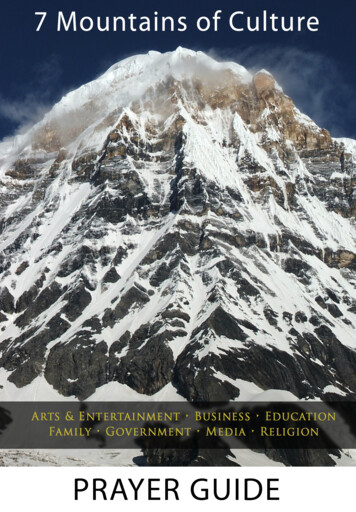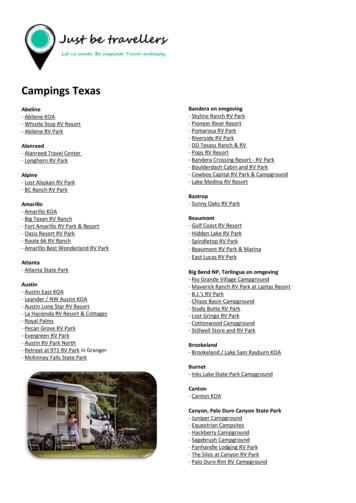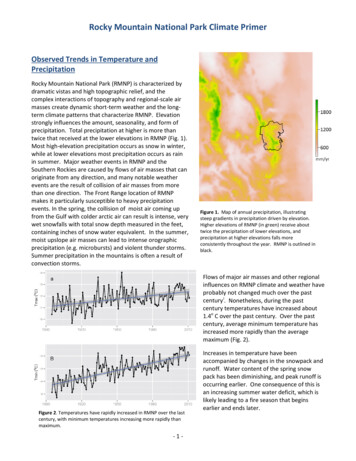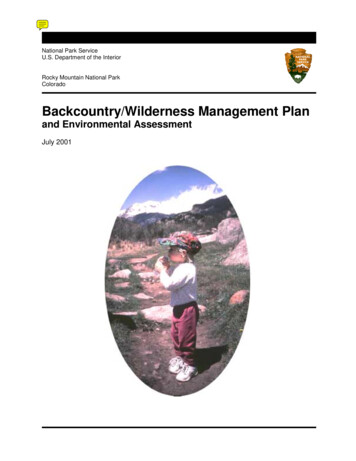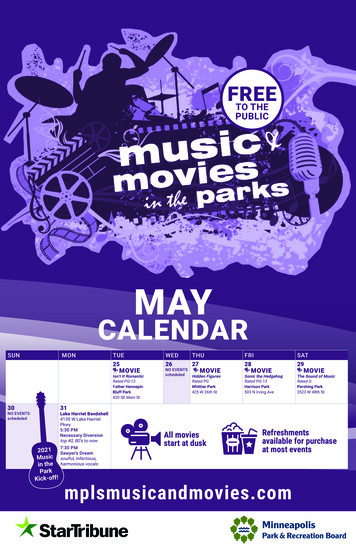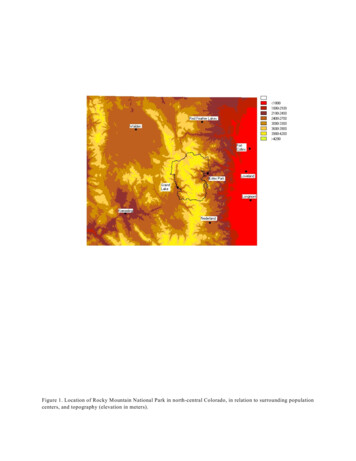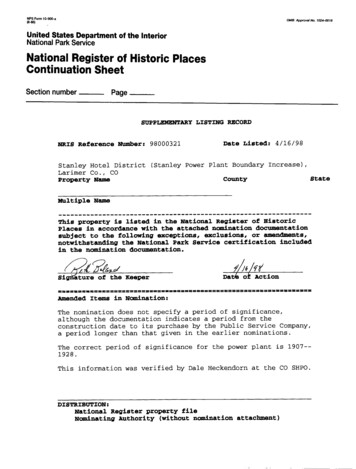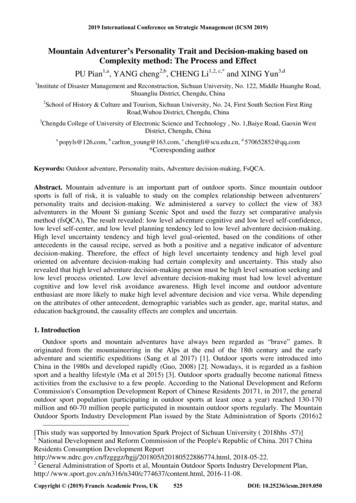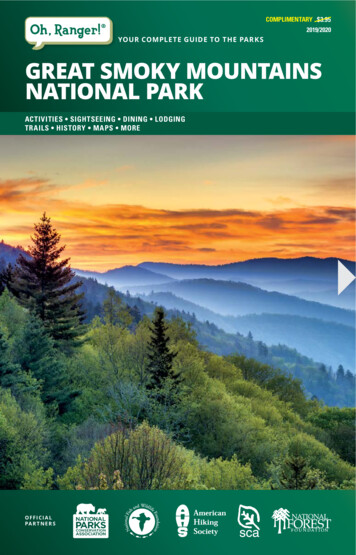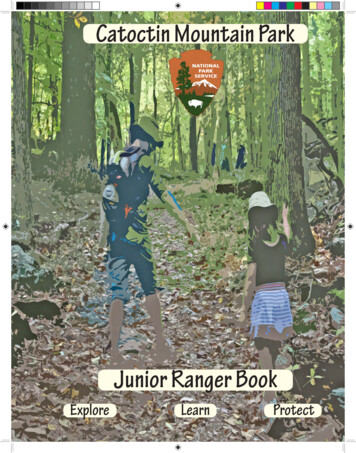
Transcription
Catoctin Mountain ParkJunior Ranger BookExploreLearnProtect
Hello Junior Ranger and WELCOMEto Catoctin Mountain Park!As one of over 400 sites protected by theNational Park Service, Catoctin MountainPark is a place where you can enjoy natureand explore the rich and vibrant history ofthe mountain and its people.From its early beginnings in the 1930’s allthe way to today, the park has served ashost to campers, hikers, nature enthusiasts,historians, and even as a getaway place formany American Presidents!Enjoy your exploration of the park as youlearn about all the wonderful things thatmake Catoctin Mountain Park so special!Chimney Rock
Let’s Get Started!Historic Park SignWolf RockOwens Creek Campground If you are 6 years old or younger,complete at least 4 activities. If you are between 7 and 9 yearsold, complete at least 9 activities.Log Cabin at Camp Misty Mount If you are between 10 to 12 years old,complete at least 12 activities. If you are over 12 years old, completeall of the activities.Over 25 Miles of Hiking Trails!Once you complete the activities, bringyour book to the Visitor Center and havea ranger review your answers with you!Be Safe & Be Courteous! Stay on all designated trails. Do not feed any of the animals. Do not pick any plants or flowers. Do not climb on any historic structures. Remember to recycle and to put all trashin a trash can.
The ArrowheadLocated within the design of the arrowhead you will find key design elementswhich symbolize the many natural, cultural, and historic resources that theNational Park Service protects and preserves. Match the images of thingsfound in Catoctin Mountain Park to the resources found on the arrowhead.Geology: Rocksand Mountains(Chimney Rock)Trees and Plants(Mountain Laurel)In 2016, the NationalPark Service celebratedits CENTENNIALanniversary. A centennialis a time span of 100years.History(Historic Log Cabins)Waterways andWetlands(Owens Creek andBig Hunting Creek)Wildlife(Black Bear)Even before the National Park Service wasformed in 1916, the United States had createdmany National Parks. Visit www.nps.gov/yell tofind out which park was the first national park.
Things To Do To Help Protect The ParkTese visitors need your help! Draw what’s missingfrom each picture to help them have a happy andsafe visit in the park!Hint: Pets need to be on a leash.Hint: Hikers need water, sunprotection, maybe long pants.What else could they use?Not so long ago, there were notmany trees or animals living on themountain. By following the rules,you can help ENSURE (makecertain) that the forest and animalsremain healthy and beautiful.Hint: Fires need to be attended or put out.Hint: Trash or recyclable items need togo into a trash can or recycle container.Ask a park ranger about other thingsthat you can do to be safe and toprotect the park.
CAN YOU TRACK THAT?Red FoxWhite-tailed DeerAlthough sometimes they are hard to see, many animals livein Catoctin Mountain Park. When you explore the park youmight see evidence of animal activity on the ground in theform of tracks. Unscramble the letters below and discoverwhat kinds of animals make these tracks.This is one of the largestanimals that live in the park.It has a distinctive “two-toe”track for each foot.The front paws of this“masked” animal lookvery similar to a humanhand, which makes it easyfor this animal to graspthings.RaccoonOpossumThis bushy-tailed animallikes to walk as straightas possible. When itwalks, it tries to put itsback paw where its frontpaw stepped!FRONTBACKI W T E HL T E D I AE R E DCatoctin Mountain Parkis more than a park!It is the HABITAT forall of the plants andanimals on the mountain.A habitat is a placewhere you can find food,water, shelter, and enoughspace to live in.N C O O A C RE D RO X FThis animal has a long tail and likes to climb trees! Ituses one of its back toes just like a thumb to hold on toparts of the tree as it climbs!FRONTBACKP M O O U S SFind out more about the different types of animalsat Catoctin Mountain Park online tm
Draw Your Visit!SpicebushTrailDuring your time here,draw a picture to showwhat fun things you didin the park.The name CATOCTIN(pronounced KA-TOCKTIN) is thought to comefrom the KittoctonAmerican Indians.Want to know more?To find out more about the people whoused to live and work on the mountain,ask a park ranger about them or .htm
Let’s Do A Leaf Rubbing!Find an interesting leaf, place it underthis paper, and color the paper withyour pencil or crayon.Most of the trees located inCatoctin Mountain Park areDECIDUOUS (pronouncedDEE-SID-YEW-US) trees.That means the trees droptheir leaves in the fall andre-grow new leaves in thespring!You can find out more about the forestin Catoctin Mountain Park by visiting:www.nps.gov/cato/learn/nature/forests.htm
Can You Find Me in the Forest?See if you can fnd the diferent animals that are hidden in the puzzlebelow. Shade in the areas that have a dot and discover where thesesneaky critters are hiding! Use the list to help you fnd them all.DRAGONFLY * DEER * RABBIT * BARRED OWL * RACCOON * BAT* SNAKE * CARDINAL * WARBLER * MOUSE * BEETLE * SQUIRREL *WOODPECKER * CHIPMUNK * FOX * GREAT HORNED OWL * FROGMany animals have adaptedtheir fur, feathers, and scalesto make them hard to see byother animals. This use ofCAMOUFLAGE helpsthem to hide.You can find out more about the animalsthat live in Catoctin Mountain Park tm
Smoke on the Mountain!Colliers sitting by theirdirt and wooden hutThe charcoal industry arrived at Catoctin Mountainduring the late 1770’s when the nearby CatoctinFurnace was built. To keep the furnace burning, thecolliers (pronounced coll-ee-erz) burned many of thetrees on the mountain to convert the wood intocharcoal. It could take up to two weeks to slowlyburn the wood in dirt covered mounds called hearths.Can you guide the woodcutter sled along themountain to get to the collier’s charcoal hearth?StartWoodcutter SledCharcoal hearth display locatedon the Charcoal Exhibit TrailIf you stacked a pile ofwood 4 feet high, 4 feet wide,and 8 feet long, that is calleda CORD. Colliers couldmake 30-35 bushels of charcoal from one cord. A bushelof charcoal weighs about 30pounds. How many bushelsdo you weigh?CharcoalHearthYou can explore the story of the woodcutters and colliers of Catoctin Mountainby hiking the 1/2 mile Charcoal ExhibitTrail near the Thurmont Vista parking area.
Which Leaf? Which Oak?Howdy! My name is Billy. Not so long ago,farmers like me would bring our pigs up to aspecial place on the mountain that has largeboulders and once had a lot of oak trees. Whenthe oaks dropped their acorns, the pigs wouldgobble them up. YUM! YUM! That’s why wenamed this place HOG ROCK! There are threemain types of oak trees that live here on themountain. Do you know how to recognize themjust by looking at their leaves?Draw a line from the description to the the correct oak leaf.Red Oak LeafI can grow 5 to 8 inches inlength and I can have 7 to 11pointy-tipped lobes.White Oak LeafI can grow 4 to 9 inches inlength and my lobes arerounded at the tips.Chestnut Oak LeafI can grow 6-9 inches in length!I am oval-shaped and my lobeslook rounded and wavy.A LOBE is a distinct edge,protrusion, or extension of aleaf. A leaf can have MANY,MANY lobes!Take a stroll on the Hog Rock Nature Trailand you will find labeled signs that will assistyou in identifying many of the other trees thatgrow near Hog Rock.
Many YearsMany PeopleOne MountainBlue Ridge Summit Vista16001700180019002000Create your own Catoctin Mountain Park timeline by writing in the eventnumber listed below to the correct circle in the timeline listed above.1234Catoctin Mountain RecreationalDemonstration Area created.(1936)Te Catoctin Furnace is built.Charcoal industry begins onthe mountain. (1774)Afer over 8,000 years ofuse, American Indians stopquarrying rhyolite and othertypes of stone on the mountain.(about 1600)National Park Service celebratesits 100th birthday! (2016)To make razor sharp tools andprojectile points, AmericanIndians would carefully flake offsmall pieces of rock from abigger rock with the use of stonesor animal bones. This is calledKNAPPING (NAPPING.)5European settlers arrive and buildtowns near the mountain. (1730’s)6Catoctin Mountain Park established.(1954)7Charcoal industry ends. Loggingand lumber industries continue toharvest the trees on the mountain.(1890’s)8Western Maryland Railroad established.Its tracks run near the mountain. Tefrst railroad “tourists” arrive at localhotels & resorts. (1872)You can find out more about the types ofindustries that once operated on CatoctinMountain by ries.htm
Let’s Go Camping!While you’re tent camping at Owens Creek Campground or at one of thehistoric cabins at Camp Misty Mount, always make sure your visit is safe andenjoyable! Play the camping game below with a family member or friend andlearn what you should and should not do while camping.Use small rocks, nuts, or coins as game pieces and place them on the “Start”square. Take turns fipping a coin. If your fip is heads, move 2 spaces. If it istails, move 3 spaces. Follow the instructions in the space you land on.FINISHYou forgotto putout yourcampfre.Go back tostart.vYou pokeda snakewith a stick.Move back3 spaces.ed.STARTIn the the early 1900’s a disease killedall of the AMERICAN CHESTNUTtrees that were on the mountain. Whenthe park began in 1936, these dead treeswere used to build all of the cabins.You can find out more about the cabin camp andtent campground at Catoctin Mountain Park at:www.nps.gov/cato/planyourvisit/campgrounds.htm
Let’s Build a Park!NAILSNAILSNAILSStarting in 1936, during the time of the GreatDepression, work began on what we now callCatoctin Mountain Park. Back then, it was calledthe Catoctin Recreational Demonstration Area.Members of the CCCworking on road construction.Building the Visitor Centerin 1941.President Franklin Delano Roosevelt hadworkers from the Works Progress Administration(WPA) and Civilian Conservation Corps (CCC)do things like build the log cabins at CampMisty Mount and Camp Greentop. Tey alsobuilt other places like the blacksmith shop atCamp Round Meadow and the Visitor Centeralong Park Central Road.But that’s not all they did!Tey also planted trees to make a new forest onthe mountain they made trails so that peoplecould go hiking .they even built roads so thatpeople could drive through the park!But there was still even MORE work to do!Worker Housing atCamp Round Meadow in the 1930’s.
When Lyndon B. Johnsonwas President in the 1960’s,members of the newlyformed Job Corps cameto the park to continue thework of the CCC and WPA.Word FindTe workers of the JobCorps repaired and updatedmany of the old buildingsalong with improving thehiking trails in the park,like the Spicebush Trail atthe Chestnut picnic area.Find the words listed below in the puzzle.President Johnson meetingJob Corps workers atCatoctin Mountain Park.The GREAT DEPRESSIONoccurred between 1929 - 1939. It wasa difficult time for most Americans asmany people were out of jobs.Thousands of new jobs were createdwith the establishment of the WPAand CCC. Many in this new workforceearned their paychecks in nationalparks.BLACKSMITH SHOPCABINSCCCCHESTNUTGREAT DEPRESSIONGREENTOPJOB CORPSJOHNSONMISTY MOUNTRECREATIONALROADSROOSEVELTROUND MEADOWTRAILSVISITOR CENTERWPAThe very first Job Corps camp created in Americawas here at Catoctin Mountain Park. You can findout more about what the Job Corps did at the parkby corps.htm
Let’s Explore Catoctin Mountain Park!Test your map skills by matching thenumbered locations on the park mapto the location clues given.13Foxville-Deerfield RoadOwens CreekCampgroundNORTH2EASTWEST8SOUTH3Park Central Road12Camp Round MeadowChestnutPicnic Area11Hog RockParking Area457Manahan Road1096---- .TrailsXCunningham Falls1Visitor CenterPark HeadquartersWheelchairAccessiblePicnic AreaParking AreaTent CampingSleeping ShelterRanger StationCabin CampingOverlook
Location CluesYou can sleep in the Adirondack Shelters which are located in thenorthernmost section of the park.Te Sawmill Exhibit is alongside Foxville-Deerfeld Road and directlyeast of the Owens Creek Campground.&Te most northeastern overlook in the park is the TurmontVista Overlook. Nearby is the Charcoal Exhibit Trail.Te Blacksmith Shop is located in the southwestern corner of the parkat Camp Round Meadow. It is found on the west side of Manahan Road.Te short trail located west from the Visitor Center will lead you to theWhiskey Still exhibit.&Hiking east and then north on the trail from Park Headquarterswill take you to Chimney Rock Overlook . Continue on the trailnorthwest and you will come to Wolf Rock.Te wheelchair and stroller accessible Spicebush Trail is found alongPark Central Road at the Chestnut Picnic area.&From the Hog Rock Parking area, you can head northeast tothe Blue Ridge Summit Overlook. From the same parking areayou can go south to get to the Hog Rock Overlook.Te historic log cabins at Camp Misty Mount are located north fromthe Visitor Center and east from the Hog Rock Overlook.Camp Greentop, found just south of the Chestnut Picnic Area, wasestablished to ofer camping experiences for disabled youth groups.You can test your map and compassskills further with the park’s twoORIENTEERING courses. Checkwith a park ranger to find outwhen the courses are open.To find out about the many other places youcan visit in Catoctin Mountain Park visit:www.nps.gov/cato/planyourvisit/maps.htm
The Rockin’ Geology atHog Rock!About 500 million years ago the green colored stone found at Hog Rockwas molten lava. The lava eventually cooled and formed an igneousrock known as basalt. The basalt sat lower than some of the surroundingland. Later on, the adjacent land eroded and the basalt was covered insediment. Over a long period of time this basalt became buried beneathother rocks and later, covered by an OCEAN!!Boulder Field on Hog Rock TrailCatoctinGreenstoneContinuous change resulted in the land being forced up into a mountain.Tremendous heat and pressure changed the basalt into a metamorphicrock. Over millions of years the layers of rock on top eroded away,revealing the greenstone. Today, this rock is locally known as CatoctinGreenstone.When hiking to Hog Rock, you are in the Blue Ridge geologic province.To your west lies the ridges and valleys of the Appalachian Mountains.To your east are the rolling hills of the Maryland Piedmont, visible fromHog Rock.SEDIMENT can be made of many things, including pieces of rock that wash away off themountain. The sandy material you find in the streams is sediment that once was part of largerrocks on the mountain.
Fill in the blanks below using the information from the story about thegeology of Hog Rock. Each blank represents one letter. When you are done,use the letter in each box to discover another name for Catoctin Greenstone.The rock around you was lava 500 years ago.Rocks in the park are constantly wearing away and .The rolling hills visible from Hog Rock are part of the Maryland.The Catoctin Mountains are part of theMountains.The greenstone was once under an ocean.To see the Maryland Piedmont from Hog Rock, you must look .Small pieces of rock known as still wash awayevery year.The rock that makes Hog Rock was 500 million years ago.Hog Rock is in a geologic province we know as the.is the common name for the metamorphic rock that makes Hog Rock.Use the letters from each box above to solve below:Catoctin Greenstone is also known as .To find out more about Catoctin Greenstone andthe incredible geological history of the area, y.htm
A Crossword Fit for the President!(Read the story to fnd the answers to the Crossword Puzzle.)During World War II, President Franklin Delano Roosevelt needed a cool place to go to get awayfrom the heat and stress of Washington. He chose a site in what is now Catoctin Mountain Park.During World War II, he sometimes brought Britain’s Prime Minister Winston Churchill to theretreat he called “Shangri-La” so they could plan out how to fght the war.Even though President Harry Truman seldom used Shangri-La, he did not want it turned over to theState Park System. Instead, half of the land known as the Catoctin Recreational Demonstration Areawas given to the State of Maryland and the other half was retained by the National Park Service.President Dwight Eisenhower renamedthe retreat “Camp David” afer hisfather and grandson. Afer World War II,Eisenhower met with Nikita Khrushchev,the Soviet chairman, to work outproblems between the two countries.President Richard Nixon made manychanges to the retreat. Nixon used thecamp more than most presidents, bothto entertain foreign dignitaries and to getaway from Washington.A historical peace summit took placeduring the Presidency of Jimmy Carter.Egyptian President Anwar Sadat andIsraeli Prime Minister Menachem Begin were brought together, both wantingpeace in the Middle East. A peace treatybetween Egypt and Israel was fnallysigned afer much debate.President Ronald Reagan seldom broughtdignitaries to the camp even though heused it more than previous presidents.He did meet with British Prime MinisterMargaret Tatcher prior to talks withSoviet leaders about arms reductions.ACROSS:(3) Hosted peace summit(4) Renamed the presidential retreat“Camp David”(8) Egyptian President during the CarterAdministration(9) Israeli Prime Minister during the CarterAdministration215332nd U.S .PresidentFranklin Delano Roosevelt64789Shangri-La SignDOWN:(1) British Prime Minister during the ReaganAdministration(2) British Prime Minister during World War II(5) Made sure Shangri-La stayed in the NationalPark System(6) Had Shangri-La created(7) Wanted arms reductions with the Soviet Union
Code Breaking AtCamp Greentop!KEY:During World War II, Catoctin Mountain Park was closed tocivilians and used by the military. Along with serving as a placefor soldiers to find rest and recreation, some individuals secretlytrained here to become Allied spies with the Office of StrategicServices (OSS) at both Camp Greentop and Camp Misty Mount.Many of the spies who completed their training at these campswere placed in Northern European countries to secretly spy onenemy activities.Using the Spy Code Keyon the right, match theleter with the numberto decipher the messagebelow.OSS Recruits at CampGreentop During World War II20 18 10 9 1413 18 10 618 10 26 1411 14 10 9 25 14 7Learning how to decipher codes wasjust one of many things that OSSrecruits had to learn to be anESPIONAGE AGENT (spy).Fitness training, sharpshooting, andhand-to-hand combat were just a fewof the many skills that OSS recruitslearned here at Catoctin Mountain Park.23 12 5Using a computer, you can see declassifiedmovies of OSS recruits training at CatoctinMountain Park at:www.youtube.com/user/catoctinnps
The Cool Things I Learned!Find the special words that are located in the yellow boxes of the activitypages in this Junior Ranger Book. Use them to fll in the blank spaces below.American Indians made sharp tools byanimal bones.rocks with stones orTe WPA and CCC were established during theto create thousands of jobs for people out of work. Many of them would go on tohelp build the park.Some animals useto help them to hide.Wood from thelog cabins in the campgrounds.From aTe nameIndian people.was used to make theof wood, colliers could make 30- 35 bushels of charcoal.is thought to come from the Kittocton AmericanTe sandy material you fnd in streams is called.Trees that drop their leaves in the fall are calledtrees.If you wanted to see how well you can use a map and compass, you could try oneof thecourses here in the park.Ais a distinct edge, protrusion, or extension of a leaf.Learning how to decipher codes was just one of many things that OSS recruitshad to learn to be an.In order to have a healthyfood, water, shelter, and space.Aanimals and plants need enoughis a 100 year anniversary.To make certain we keep the forest and animals healthy in the park, alwaysyou follow the park rules.
Junior Ranger OathAs a Junior Ranger.I pledge to do my best to protect thenatural, cultural, and historical resourcesof our national parks. I will follow allpark rules to ensure that all of my visitswill be safe and enjoyable. I will continueto explore and learn about what makesnational parks so special.I will wear my Junior Ranger badge withpride and will be helpful and respectful toall people. Lastly, I will share with peopleall of the wonderful and special thingsthat I have learned about CatoctinMountain Park.
Park Ranger SignaturePassport Stampfor successfully completing all requirements and activitiesto become a Junior Ranger atCatoctin Mountain Park.This certificate is awarded to
One Mountain Blue Ridge Summit Vista Create your own Catoctin Mountain Park timeline by writing in the event number listed below to the correct circle in the timeline listed above. Catoctin Mountain Recreational Demonstration Area created. (1936) Te Catoctin Furnace is built. Charcoal industry begins on the
